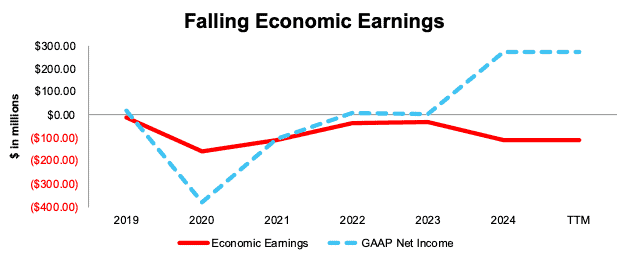Walmart recently announced that U.S. tariffs on imported goods will necessitate price increases, despite the company’s ongoing commitment to affordability. Following the announcement and quarterly revenue below expectations, Walmart’s stock saw a modest decline.
Walmart is unlikely to be the only company facing such pressures. Until the broader effects of tariffs fully surface, the full economic impact of the chaos over the last few weeks is unknown.
What is clear, however, is that companies already facing operational challenges are likely to be hit the hardest. Many businesses continue to trade at inflated valuations – propped up not by fundamentals, but by speculative narratives and fickle market enthusiasm. These stocks are “ticking time bombs” and carry significant downside risk.
We created the Most Dangerous Stocks Model Portfolio to help investors steer clear of these stocks. This Model Portfolio highlights the worst offenders, stocks with poor fundamentals and excessive valuations, so you can avoid them with confidence.
If you prefer to avoid danger, too, then we hope you enjoy this free stock pick from our Most Dangerous Stocks Model Portfolio.
This free stock feature provides a summary of how we pick stocks for this Model Portfolio. It is not a full Danger Zone report, but it gives you insight into the rigor of our research and approach to picking stocks. Whether you’re a subscriber or not, we think it is important that you’re able to see our research on stocks on a regular basis.
We’re proud to share our work. Please feel free to share it with your friends and family.
Keep an eye out for the free pick from our Most Attractive Stocks Model Portfolio, which will be published this week as well! The work that goes into that report is just as valuable.
We update this Model Portfolio monthly. The latest Most Attractive and Most Dangerous stocks Model Portfolios were updated and published for clients on May 6, 2025.
Free Most Dangerous Stock Pick: Pursuit Attractions and Hospitality Inc (PRSU)
Pursuit’s (PRSU: $31/share) net operating profit after tax (NOPAT) margin rose slightly from 5% in 2019 to 6% in the TTM, while the company’s invested capital turns fell from 1.1 to 0.1 over the same time. Falling invested capital turns offset rising NOPAT margins and drive Pursuit’s return on invested capital (ROIC) from 5% in 2019 to <1% in the TTM.
Pursuit’s economic earnings, the true cash flows of the business, fell from -$13 million in 2019 to -$112 million in the TTM. Meanwhile, the company’s GAAP net income rose from $21 million to $271 million over the same time. Whenever GAAP earnings rise while economic earnings decline, investors should beware.
Figure 1: Pursuit’s Economic vs GAAP Earnings Since 2019
Sources: New Constructs, LLC and company filings
PRSU Provides Poor Risk/Reward
Despite its poor and declining fundamentals, Pursuit’s stock is priced for significant profit growth, and we believe the stock is overvalued.
To justify its current price of $31/share, Pursuit must improve its NOPAT margin to 6% (equal to all-time high margin) and grow revenue by 21% compounded annually through 2034 (compared to revenue falling 19% compounded annually over the last ten years). In this scenario, Pursuit’s NOPAT would grow 24% compounded annually through 2034. Contact us for the math behind this reverse DCF scenario. We think these expectations are overly optimistic, especially considering the company’s NOPAT fell 15% compounded annually over the last decade.
Even if Pursuit improves its NOPAT margin to 6% and grows revenue 12% compounded annually through 2034, the stock would be worth no more than $10/share today – a 68% downside to the current stock price. Contact us for the math behind this reverse DCF scenario.
Each of these scenarios also assumes Pursuit can grow revenue, NOPAT, and FCF without increasing working capital or fixed assets. This assumption is unlikely but allows us to create best case scenarios that demonstrate the high expectations embedded in the current valuation.
Critical Details Found in Financial Filings by Our Robo-Analyst Technology
Below are specifics on the adjustments we made based on Robo-Analyst findings in Pursuit’s 10-K and 10-Q:
Income Statement: we made over $600 million in adjustments, with a net effect of removing under $300 million in non-operating income. Professional members can see all adjustments made to the company’s income statement on the GAAP Reconciliation tab on the Ratings page on our website.
Balance Sheet: we made over $600 million in adjustments to calculate invested capital with a net increase of over $500 million. One of the most notable adjustments was for asset write downs. Professional members can see all adjustments made to the company’s balance sheet on the GAAP Reconciliation tab on the Ratings page on our website.
Valuation: we made just under $400 million in adjustments to shareholder value, with a net decrease of over $300 million. The most notable adjustment to shareholder value was for total debt. Professional members can see all adjustments to the company’s valuation on the GAAP Reconciliation tab on the Ratings page on our website.
This article was originally published on May 16, 2025.
Disclosure: David Trainer, Kyle Guske II, and Hakan Salt receive no compensation to write about any specific stock, style, or theme.
Questions on this report or others? Join our online community and connect with us directly.

